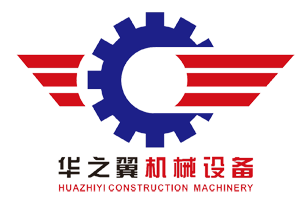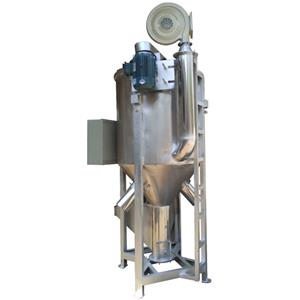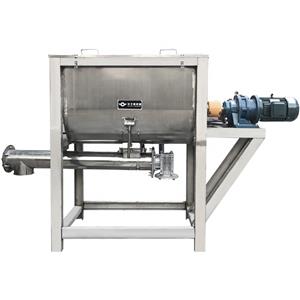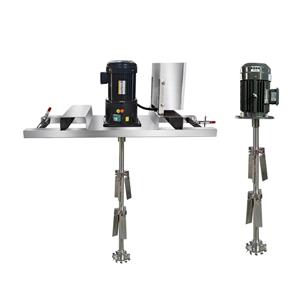Horizontal ribbon mixer
Horizontal ribbon mixers are widely used in chemical, pharmaceutical, food, building materials and other fields.
The main shaft inside the mixer is coiled with 2 layers of spiral belts in different directions. Driven by power, the material is rapidly stirred. The equipment has the characteristics of good mixing uniformity, high production efficiency, and extremely low failure rate. The equipment is a batch mixer, and the appropriate equipment model is selected according to how many materials are processed in each batch.
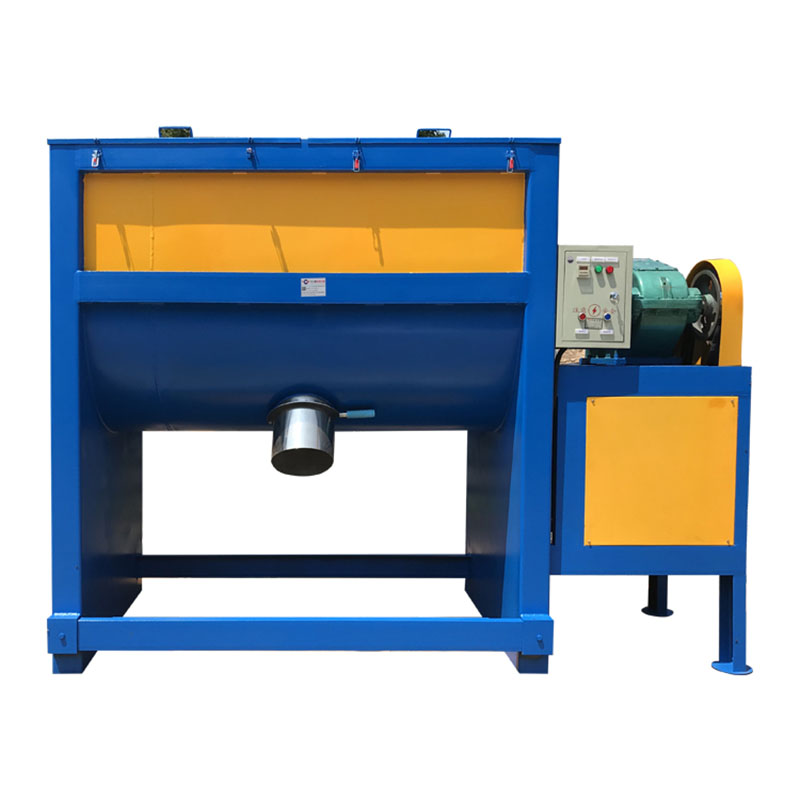
The processing capacity of each batch is 0.1~20 cubic meters
0.3~15 tons of materials per batch
The mixing time used is 3 to 15 minutes
Equipment material can be 316L, 321, 304, carbon steel
The horizontal ribbon mixer is basically composed of a mixing bin, agitator, and a driving device. The U-shaped tubular bin is equipped with a double-layer anisotropic ribbon coiled agitator shaft, and the outer helix is driven by power, and its coiled form rotates The direction pushes the material from the two ends of the U-shaped silo to the belt, while the inner spiral belt pushes the material from the middle to the two ends to form a convection mixing. There is a discharge port at the bottom of the horizontal cylinder of the mixer, and the spiral structure of the outer helical belt cooperates with the rotation direction of the main shaft to drive the material inside the cylinder wall to the discharge port for discharging, so as to ensure that there is no dead angle for the material in the cylinder to be discharged.
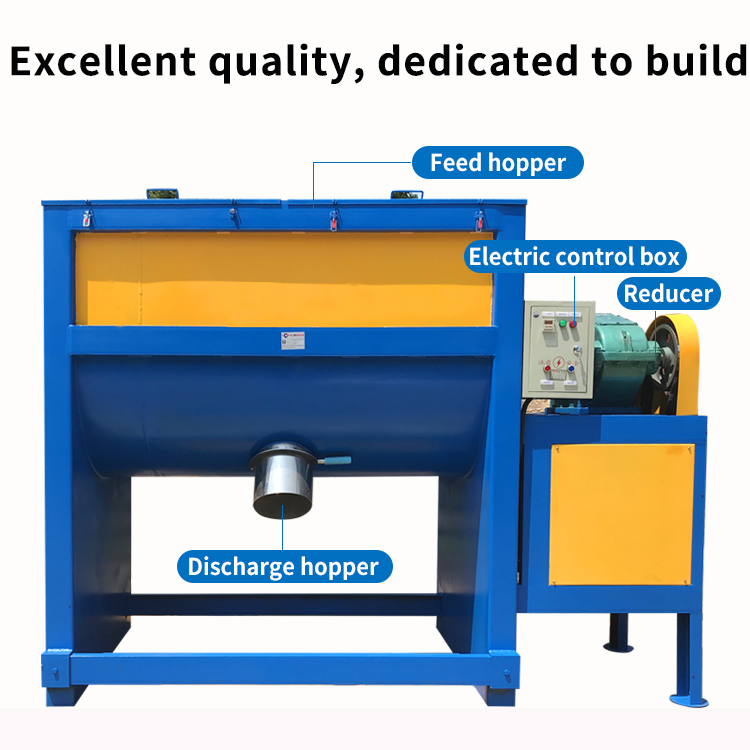
1. Flexible material selection scheme
The mixer can be customized with carbon steel, manganese steel, 304 stainless steel, 316L stainless steel, 321 stainless steel and other materials, and different materials can also be used in combination; when selecting equipment materials, distinguish: the part in contact with the material and the part not in contact with the material; mixing The interior of the machine can also be targeted to add functional coatings or protective layers such as anti-corrosion, anti-bonding, isolation, etc. The surface treatment of stainless steel is divided into sandblasting, wire drawing, polishing, mirror surface and other treatment methods, which can be applied to different parts of use. ;
2. Reliable drive configuration
The mixer is equipped with drive devices with different capacities, different powers, and different output speeds according to the material properties, starting methods, and stirring methods.
The selection of drive motors are: ordinary motors, explosion-proof motors, variable frequency motors, energy-saving motors, high-protection-level motors, and motors under different voltages;
Commonly used reducers: R, K, F series gear reducers, cycloidal pinwheel reducers, universal gear reducers, planetary gear reducers;
Common connection methods: direct connection, pulley connection, hydraulic coupling connection.
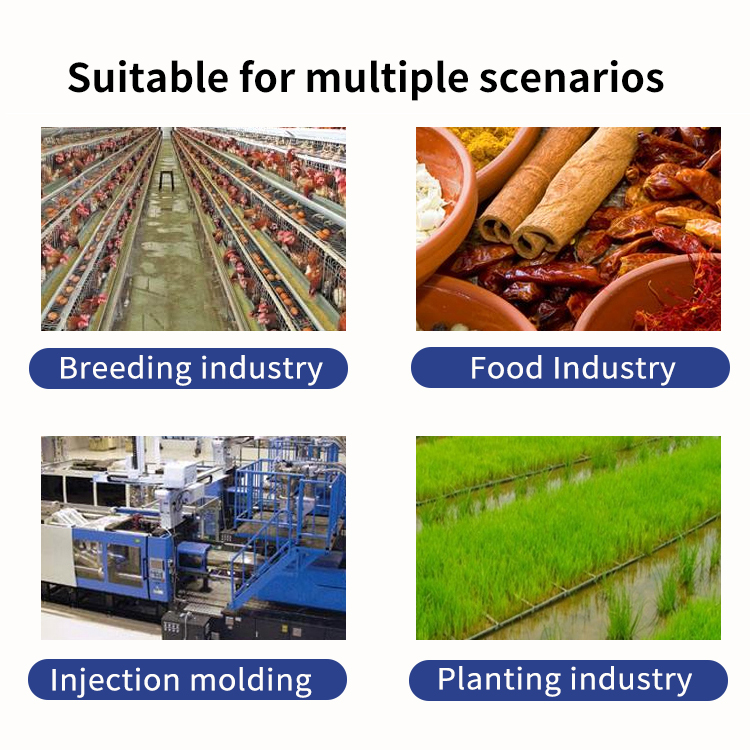
3. Stirring device
The mixer can be equipped with different agitators according to different material properties; conventional material mixing points: mixing different powders with each other, batch mixing of the same material, adding a small amount of liquid to the powder, adding powder to liquid and stirring to slurry, slurry Thickening or dilution of materials, mixing of granules and powders, mixing of granules and granules, crushing and mixing of agglomerates, cooling or heating mixing, etc.
The agitator modified by the horizontal mixer can be divided into: inner and outer double-screw type, paddle ribbon type, inner and outer broken ribbon type, razor type, etc.
4. Excellent discharge device
The horizontal ribbon mixer is conventionally equipped with a pneumatic curved flap valve. When the valve is closed, the curved flap of the valve fits the curved surface of the cylinder. During the stirring process, there is no excess stirring dead angle, so that the mixture is more uniform.
The drive of the valve can be divided into three types: manual, pneumatic and electric.
Valves for reference include powder spherical valve, roller valve, plum blossom valve, powder butterfly valve, rotary feeding valve, etc.
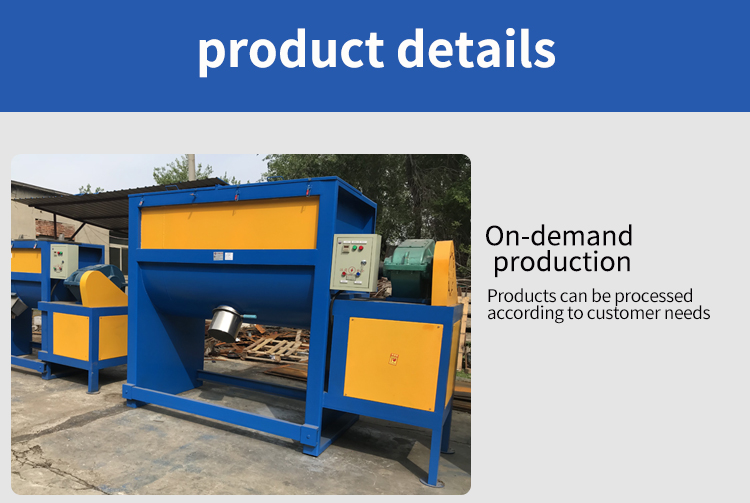
5. Various opening methods
Different forms of openings can be set on the cylinder cover of the mixer to meet different working conditions. According to the opening function, manholes, cleaning doors, feeding ports, exhaust ports, dust removal ports, etc. can be set up. The mixer can be set to fully open the cylinder cover, which is convenient for cleaning the inside of the equipment.
6. Powerful auxiliary components
The mixer can be installed with a variety of components, commonly used are coil steam jacket, honeycomb pressure jacket, circulating medium jacket, online sampling valve, high-speed flying knife, magnetic separator, temperature detection, weighing system, components such as dust removal and purification.
The jacket of the mixer adopts different forms of jacket according to different heat source media, which can be heated and cooled, and the maximum temperature is within 250 degrees Celsius. When adding a small amount of liquid, it is necessary to configure a liquid spray device, which is more conducive to the uniform dispersion and mixing of the liquid in the main material. The liquid spray system consists of three basic modules: pressure source, liquid storage tank and spray head.
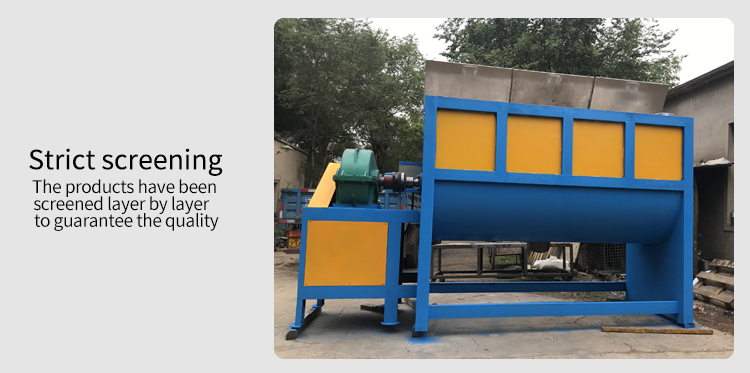
7. Tight moving shaft seal
There are 3 kinds of sealing modes commonly used in mixers: packing seal, combined air seal, mechanical seal; spindle seal used to solve the state of particles, powder, micron powder, liquid and slurry.
1. Determine the volume of materials mixed in each batch, ranging from 0.1 to 20 cubic meters, and select equipment of corresponding specifications.
2. Select the material for making the equipment. The material is divided into: the part in contact with the material, the part not in contact with the material, and the other parts of the equipment keep the original material. (The material is determined according to the material properties, working condition requirements, hygiene level and other factors, conventional carbon steel, 304/316L/321 stainless steel) (After the material is selected, the surface treatment requirements are determined according to the requirements)
3. Determine the driving capacity of the configuration according to the specific gravity, fluidity and other properties of the material, as well as the starting standard. (Startup standard points: heavy-load startup, no-load startup)
4. According to the actual process situation, add auxiliary function components, such as liquid spray, heating/cooling, etc.
5. The opening requirements of the equipment, such as feeding port, cleaning port, exhaust hole, etc.
6. Select the discharging mode and driving mode, which can be divided into manual, pneumatic and electric.
